With the best XLR microphones, you can enjoy crystal-clear, high-quality sound no matter what you’re recording or performing.
Whether you’re creating podcasts, making music, or recording a video, XLR microphones provide the precision and clarity necessary to capture excellent audio.
You might worry that XLR microphone models won’t fit your budget, but the truth is they come in a range of prices.
I’ve reviewed dozens of XLR mics over the years, and have curated a list of what I believe are the 16 very best XLR microphones available in 2023.
I’ve included picks for every budget, ranging from XLR mics under $100 to models that cost several hundred dollars.
Let’s get started…
Disclosure: Some of the links in this article are affiliate links, meaning at no additional cost for you, we might get a commission if you click the link and purchase.
Quick Picks for the Best XLR Mics
Don’t feel like reading this complete guide to the best XLR microphones? Here are a few picks that I feel are a cut above the rest.
 Audio-Technica AT2025 Cardioid Condenser Studio XLR Microphone
Audio-Technica AT2025 Cardioid Condenser Studio XLR Microphone
What’s inside?
- High SPL handling and wide dynamic range
- Custom designed low mass diaphragm that offers great frequency and transient responses
- Noise level of 20 dB SPL
Killer feature: Reduces any background noise and sounds, which improves voice and desired sound
My top pick is the best XLR microphone out there, but it’s far from your only option. No matter what you want to do with your device or how much you can afford to spend, make sure that you check out my other top picks.
 Shure PGA48 Dynamic Microphone - Handheld Mic for Vocals with Cardioid Pick-up Pattern
Shure PGA48 Dynamic Microphone - Handheld Mic for Vocals with Cardioid Pick-up Pattern
What’s inside?
- Handles all types of speech patterns and voices
- Convenient power switch
- Response range of up to 15,000Hz
- Adapter for use with stands
- Zippered storage pouch
Killer feature: Rejects unwanted sounds
As one of the most affordable XLR microphones in the world, the PGA48 weighs less than two pounds and is great for carrying around. If you still aren’t sure if it can meet all of your needs though, take a look at my other top pick.
 Shure SM7B Vocal Microphone
Shure SM7B Vocal Microphone
What’s inside?
- Bass roll-off and mid-range controls with graphic display
- Internal air suspension shock isolation
- Very effective pop filter
Killer feature: Wide-range frequency response that will produce clean and natural sound for speech and music
Capable of rejecting electromagnetic humming and the other noises that you hear when working, it’s no wonder that the SM7B is so popular with shoppers. Though this isn’t my top pick, I think it’s a great model for the money.
I also encourage you to take a look at the SM58-LC from Shure, which has a stronger frequency range than other affordable choices do at 50 Hz to 14 kHz. With the included break-resistant stand and zippered storage case, you can use this device almost anywhere.
How to Choose the Best XLR Microphone for Your Needs
This guide will help you in choosing the best device considering all your wishes and opportunities.
Step 1: Consider Your Content
One of the most important things to consider when choosing an XLR mic is the type of content that you want to create.
Do you dream of streaming video games online and picking up fans who will turn to you for tips on future releases?
Maybe you want to become a streamer who shares tips on making it in the entertainment industry or becoming a successful writer.
Some XLR microphones are perfect for podcast creators, too.
Whether you focus on restaurant reviews or true crime, you need a device that can pick up your voice and anyone you bring onto your podcast. You’ll also find devices that can handle any interviews that you do to introduce guests to your audience.
The models designed for other types of recording are a little different. Though some are perfect for singers, others are better suited for musicians. A model designed for singers will ensure that it picks up every note that you hit and records those notes. You can hear those notes when you play the song back. Models for musicians work with all types of instruments, including guitars and drums.
I recommend that you identify the content that you want to create before choosing an XLR model.
Step 2: Factor in Your Budget
Though it’s easy for some shoppers to drop thousands of dollars on new equipment without thinking twice, not everyone is as lucky. You do not need a top-of-the-line or state-of-the-art mic to start your first podcast.
Some of the XLR microphones priced at $100 or less can help you create a podcast that people love. As you build up your audience and get ad revenue, you can spend a little more on a new device and other equipment.
Make sure that you think about your budget in terms of everything that you need and not just a recording device. Do you need speakers that let you hear your recordings or editing software to edit your work before putting it online? Maybe you need a few cables that you can run around your recording studio or soundproofing supplies to block out the street sounds.
When you sit down and create your budget, think about how much you want to spend in total. You can then look at how much you can afford to spend on all of the equipment that you need.
Step 3: Look at the Types of Microphones
Once you decide to start shopping for a recording mic, think about whether a dynamic or condenser microphone is best for you.
Looking at where you will use it and the sounds that you want to capture can help you choose which one is best for your needs.
Let’s say that you want to record hard rock music or songs backed by multiple instruments. Dynamic mics are best for those situations.
A dynamic mic can pick up the strongest of voices and ensure that any instruments in the background also come through.
Dynamic mics also come in handy when you want to play live because the device ensures that the audience can hear you over the roar of the crowd.
Condenser mics are usually better for studio sessions. They do a better job of picking up lighter and softer sounds.
Have you ever worked with someone who spoke so softly that you could hardly hear them when standing beside them? Now try to imagine using a microphone to pick up that person’s voice.
Condenser mics can pick up soft voices without requiring that the person stand close to the device.
You’ll also find that condenser mics are better for studio sessions with recording artists who have higher singing voices.
Step 4: Think About the Environment
Choosing the right XLR device will also require that you think about your main recording environment. Do you plan to spend a lot of time in a professional studio that has soundproofed walls and new equipment? Those sessions will require a model that is compatible with all of your equipment. If you plan on spending a lot of time on the move such as recording interviews for a podcast, you want one that weighs less and has an ergonomic design that can fit in your hand.
You’ll also find that those designed for home studios are often different from those used in pro studios. A home model may come with a zippered pouch or another type of bag. This allows you to keep the device safely stored between your recording sessions and keep it away from dust. You can also use the pouch to carry the device to sessions that you schedule in the homes of others or different studios. No matter what environments are on your mind, you can easily find a microphone that works in each one. You just need to look at detailed reviews to make sure that the model can handle those environments.
Now that you know what to pay attention to while choosing a device, it’s time to get into the details. Read through my ultimate picks to find the best device for your vocals.
What are the Best XLR Microphones?
 |
One of the most affordable options available. Category: under $100
My choice among condenser microphones!
|
Amazon →SweetWater → |
 |
Its impressive features make it perfect for live streams and podcasts. Category: under $100
|
Amazon → |
 |
The leading choice on the market for podcasters. Category: under $100
|
Amazon →SweetWater → |
 |
Strong enough to use every day. Category: under $100
My choice among budget microphones!
|
Amazon →SweetWater → |
 |
Highly affordable for musicians and others. Category: under $100
|
Amazon → |
 |
Adds a professional touch to home recordings. Category: under $100
|
Amazon → |
 |
Has a compact size to keep it out of your way. Category: under $100
|
Amazon →Bluemic → |
 |
A leading choice for both singers and musicians. Category: under $100
|
Amazon →SweetWater → |
 |
Creates professional broadcasts in any setting. Category: under $300
|
Amazon → |
 |
One of my top picks for XLR mics. Category: under $300
My choice among dynamic microphones!
|
Amazon →SweetWater → |
 |
Capable of recording most voices and instruments. Category: under $300
|
Amazon →AKG → |
 |
Offers neutral and balanced recordings. Category: under $300
|
Amazon →Techzone → |
 |
Compatible with the Shure app to give you more options. Category: under $300
|
Amazon →SweetWater → |
 |
Great choice for users on the go. Category: under $300
|
Amazon →SweetWater → |
 |
Suitable for indoor and outdoor recording. Category: under $500
|
Amazon → |
 |
A nice choice for close-up voicework. Category: under $500
|
Amazon →SweetWater → |
Best XLR Microphones Under $100
Here are my reviews of the cheapest models with an XLR connector:
1. Audio-Technica AT2020
As my top pick for the best XLR microphone, the AT2020 has both a cardioid polar pattern and a unidirectional design that detect noises from all directions. Whether you stand in front of or behind the device, you can rest assured that it will hear your voice. Some found that it does a better job of picking up louder voices than softer ones though, which may mean that you need to stand a little closer when recording.
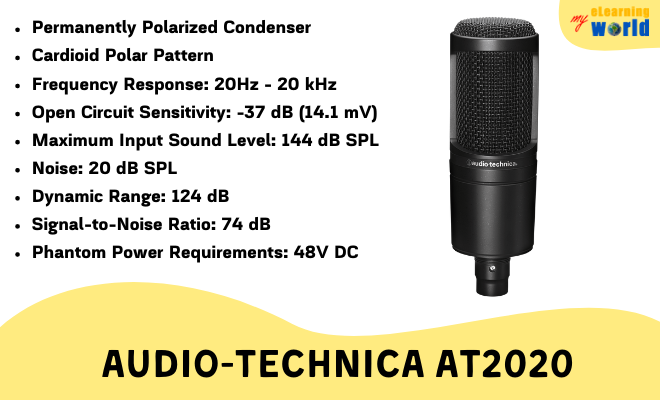
With a 20 decibel SLP rating, the AT2020 is a good option for home studios. While it detects all types of noises, it doesn’t produce as much interference that can leave the room as other models do. You’ll also like the low-mass diaphragm that extends the range of its frequency response while also helping the response last longer. Though you may think that these features only come in the most expensive models, the AT2020 shows that you don’t need to spend a lot to equip your home studio.
Top Features:
- 20 decibel SLP
- Three-pin XLR connector
- Low-mass diaphragm
- 20 to 20,000Hz frequency response range
- 74 decibel signal to noise ratio
Pros:
- Perfect for most home studio jobs
- Provides many of the same benefits that professional devices do
- Offers high quality sound
- Great choice for beginners
- Works well with loud and booming voices
Cons:
- Does not include any cables or adapters
- Not suitable for all professional projects
- You may have problems using it with a computer
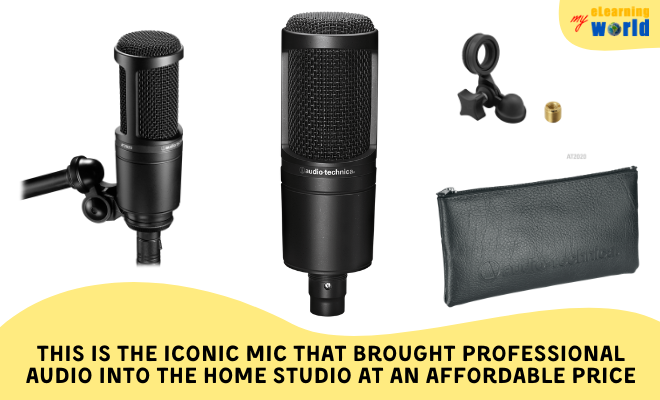
Best for: home studio recording artists
Though the AT2020 is my top pick, you don’t need to take my word for it. The video below helps you see why so many recording artists choose this model when they work at home.
Thanks to the low price tag and impressive features, it’s no wonder why so many pick the AT2020 for their home recording needs.
Buying Options:
2. Marantz Pro MPM1000
As a wired microphone, the Pro MPM1000 has a sensitivity range as low as 38 decibels. Not only does it work well for most users, but it includes mounting hardware that gives you the option of using it on a desk or with a floor stand.

The Pro MPM1000 comes with a windscreen and a shock mount that work together to block other noises such as people talking behind you and mechanical hums. I’m a big fan of this model for beginners who want to save money as they learn the ropes of podcasting and live streaming.
Top Features:
- Built-in condenser capsule
- Internal shock mount
- 20 to 20,000Hz frequency response range
- High sensitivity
- 77 decibel signal to noise ratio
Pros:
- Works with both stand and desk mounts
- Includes a windscreen for background noise elimination
- Affordable price tag
- Suitable for beginners
- Leading choice for home recording artists
- Excellent recording quality for the price
Cons:
- Doesn’t deliver the best sound quality
- May have issues picking up sounds from a few feet away
- Can sound lower than you would like

Best for: podcasts and live streaming
Take a look at one of my favorite videos to see why the Pro MPM1000 is so popular for home artists. You can watch this video before you use my link.
Whether you want to live stream or share podcasts, you may want to compare the Pro MPM1000 to similar models such as the PodMic.
Buying Options:
3. Rode PodMic
Podcasting is an easy way to reach fans and even make some money as you talk about your favorite topics. With the PodMic, you will have no problem creating content that listeners can hear on their devices.

This one has internal shock mounting that reduces vibrations to put the focus on the voices of you and your subjects. It also has a high output impedance and a low sensitivity rating that work together without phantom power to deliver the quality that you want with less editing required.
Top Features:
- Cardioid polar pattern
- 320 output impedance
- 20Hz to 20,000kZh frequency response range
- Metal construction
- Sensitivity as low as -57 decibels
Pros:
- Capsule design is perfect for interviews
- Pop filter cuts down on interference
- Easy to use with other Rode accessories
- One of the best options for podcasting
- Delivers pretty high quality audio
Cons:
- Doesn’t work well for live streams
- Works better with deeper voices
- Requires that you sit close to use it

Best for: podcasters
If you don’t have time to run sound tests at home, check out the video review of the PodMic below. You can get a good look at the sound that it delivers when using it at home.
Though the low price makes the PodMic appealing, you may want to compare it to microphones from Shure and other companies before reaching for your credit card.
Buying Options:
4. Shure PGA48
Make your living room feel more like a stage with the PGA48 from Shure. Not only is this perfect for karaoke nights with your friends and family, but it works just as well for home studio recording and podcasting.

The included XLR cable is compatible with most of your equipment and lets you hook it up without going through a bunch of steps. Shure gives you a zippered carrying pouch to keep the device safe and an adapter to use with the stand of your choice. The PGA48 can stand up to daily use and users who like to move as they record and perform.
Top Features:
- XLR connector
- Cardioid polar pattern
- Built-in power switch
- Stand adapter
- Includes a zippered carrying pouch
Pros:
- Low price
- Compatible with equipment from other manufacturers
- Comes with a holder and XLR cable
- Has an impressive sound quality
- Holds up to daily use
Cons:
- Produces more noise when you hold it vs. using it with a stand
- You can accidentally hit the power switch
- Not suitable for live or stage performers

Best for: home recording and karaoke singing
Thanks to the video below, you can see some of the top benefits of using the PGA48 at home. You can quickly watch this video before checking out my other reviews.
From home karaoke recording to podcasting, the PGA48 can handle most of your needs.
Buying Options:
5. MXL 770
Capable of picking up both instruments and voices, the MXL 770 is one of the best models to use in any studio setting. Weighing only one pound, it comes with a unidirectional polar pattern that helps it pick up the top sounds from across the room.

You get an attenuation switch that works at settings of -10 decibels along with a high frequency range. The included shock mount prevents vibrations and easily connects to different surfaces or stands. This one also comes with a rugged carrying case when you want to use it in different places.
Top Features:
- Gold diaphragm
- 30Hz to 20,000kZh frequency response range
- Attenuation switch
- Durable carrying case
- High-pass filter
Pros:
- Perfect for recording all types of voices and instruments
- Works with most types of phantom power
- A nice budget choice
- Shock mount with adapter support
- Produces sounds similar to expensive models
Cons:
- Requires both phantom power and an XLR cable to use it
- Has issues with sound isolation
- You may find that the stand is hard to use

Best for: vocal and instrument recording
To see how the 770 works in the real world, check out the following video. You can even see how well it works in sound tests.
The MXL 770 is a great option for shoppers on a budget. Once you try it, you may even think that the price was a mistake and that it’s worth more.
Buying Options:
6. Neewer NW-700
Get ready to take the world by storm with the NW-700, which is one of the few microphones that will deliver pro results in any setting. Thanks to the adjustable stand, you can now change the position of this model to make sure that it works for you. This also helps you pick up voices when you interview others along with the instruments that you use.
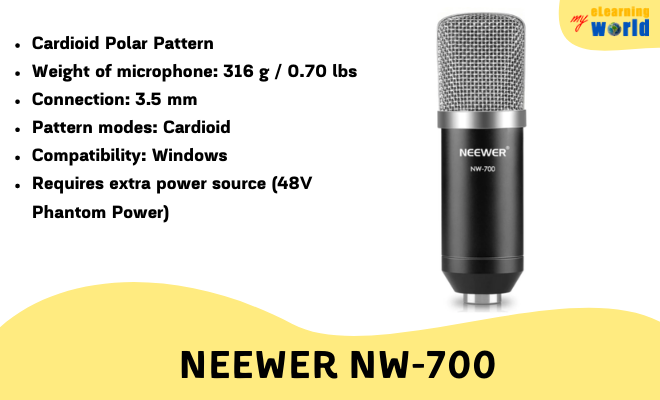
Though you do need some accessories to use this device, you get a high frequency response range as well as a windscreen that keeps it from picking up other sounds. You also get a foam cap that lets you use the NW-700 outside.
Top Features:
- Condenser model with an upgraded audio circuit
- Windscreen works as a pop filter
- Adjustable scissor arm stand
- Foam cap for outdoor use
- High frequency response range
Pros:
- Comes loaded with accessories for recording
- Adjustable stand helps you get it in the right spot
- Blocks other noises to help your vocals sound clearer
- Lets you take the device outside for interviewing and recording
- Compatible with most electronic equipment and instruments
Cons:
- Requires a sound card and other accessories to use it
- Not compatible with Macs
- Has a learning curve for new users
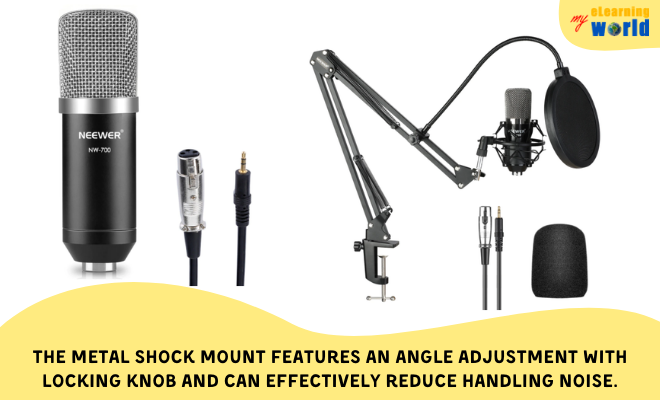
Best for: professional audio recording
See what other reviewers loved about the NW-700 in the video listed below. It might make you take the plunge and order today.
Whether you want to record a new song or work on a podcast, the NW-700 delivers the best sound quality for the money.
Buying Options:
7. Blue Ember
You no longer need to adjust your device to make sure that it doesn’t appear in your shots because this Blue Ember has a low-profile that keeps it out of the way. Not only is it more compact than other models, but it also weighs less. That makes it easy to carry it around for interviews and use it outside of your studio.
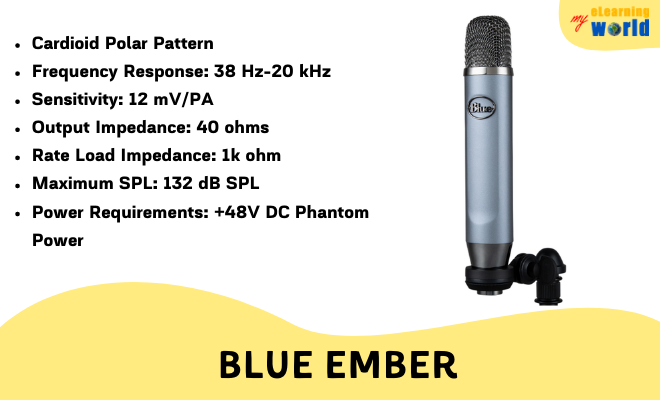
You may dislike that design though as it makes it hard to find a compatible shock mount. A shock mount is a must-have as this model can pick up soft and loud noises. Though it does not come with an XLR cable, it works with the cables that you already own to quickly connect it to all of your equipment.
Top Features:
- Built-in condenser cap
- Strong cardioid pattern
- Low-profile design
- XLR connector
Pros:
- Compact design won’t show up in your camera’s field
- Acts as an upgrade when compared to other microphones in this price range
- Easy to set up
- Compatible with lots of accessories and equipment
Cons:
- You may need a signal booster in some situations
- Works better when paired with a shock mount
- Price rises when you add the must-have accessories

Best for: podcasting and live streaming
Get a better look at this Blue Ember in the review that I found. In just a few minutes, you’ll see why so many podcasters love it.
To record live streams and podcasts at home that have a professional look, this is a great model to try.
Buying Options:
8. Shure SM58-LC
Priced at right around $100, the Shure SM58-LC delivers the sound quality and results that you expect from a Shure while also helping you save money. With a frequency response range of 50 to 50,000Hz, it can detect the softest of voices nearby and pick them up.

Shure gives you a pop filter that protects against both electronic and wind noises. Thanks to the pneumatic shock system, the SM58-LC also does a good job of cutting back on the noises produced as you move and handle it.
Top Features:
- 50 to 50,000Hz frequency response range
- Pneumatic shock-mount
- Cardioid pickup polar pattern
- Enamel and metal construction
- Built-in pop filter
Pros:
- Perfect for projecting one or more voices across space
- Suitable for all types of vocal recording
- Durable design holds up to daily use
- Stand adapter is resistant to most damage
- Works with or without a computer
Cons:
- Does not have a built-in power switch
- May need an amp to use it for projecting
- Can produce some popping sounds

Best for: vocal recording and singing
To get a better idea of how the SM58-LC from Shure can meet your needs, I encourage you to watch the video that follows. You can check it out after reading my short review.
From giving lectures that everyone in the crowd can hear to recording vocal tracks in a studio setting, the Shure SM58 has all of the features that you need.
Buying Options:
Best XLR Microphones Under $300
These models are a bit more expensive but they are also a bit better.
9. Rode Procaster
You can sit as close as you want to the Rode Procaster without worrying that it might miss some of the words that you say. Specifically designed for podcasting, it has a tight polar pattern that picks up all types of speech patterns.

Even if you interview guests with low or soft voices, you can still record them. With the included zippered pouch, you can safely store the mic between your recording sessions and keep it safe. Rode also added a built-in pop filter to reduce background noises.
Top Features:
- Unidirectional cardioid polar pattern
- 3/8-inch adapter for use with stands
- Zippered storage pouch
- Internal pop filter
- Built-in shock mount
Pros:
- Eliminates mechanical noises caused by electronics
- Offers professional sound quality
- Has the clean gain that you want
- Delivers lots of bass sounds
- Durable design for regular use
Cons:
- May need a preamp or other accessories
- Has some pickup from behind the mic
- You might notice that the internal parts move as you use it

Best for: podcasting and broadcast recording
The following video lets you see why the Procaster is such a popular choice for podcasting at home. You can see how you can use it no matter what subjects you address in your podcasts.
For both broadcast recording and podcasting, you can’t go wrong with the Rode Procaster.
Buying Options:
10. Shure SM7B
The removable windscreen that comes with the Shure SM7B both reduces some sounds and focuses on voices when you or your guests sit closer to the microphone. You can also use the pop filter when you sit close to stop this device from picking up the sound of your breath.

The captive nut stand works with the yoke mount to let your mount the microphone overhead. You can also adjust the nut as needed to change the angle of the SM7B. Shure also gives you an internal shock system that eliminates all types of mechanical noises.
Top Features:
- Removable windscreen
- Built-in pop filter
- 50 to 20,000kZh frequency response range
- 150-ohm impedance
- Mounting bracket included
Pros:
- Nice and fast response time
- Mounts overhead to detect and pick up more voices and sounds
- Adds a deeper and richer tone to some voices
- Designed to stand up to daily use
- Reduces the sounds of breathing
Cons:
- Not as sensitive as you might expect
- May require the addition of a line or signal booster
- Can pick up lots of floor noise

Best for: podcasting and live streaming
I recommend watching this short video to see some of the features that make this a good choice for podcasting. You’ll also see some of the benefits of using it for live streaming.
As it cuts back on breath sounds and picks up soft voices, the SM7B is perfect for interviewing guests and creating fun podcasts.
Buying Options:
11. AKG Pro Audio P220
AKG Pro Audio makes the P220 for those who want an affordable way to get professional results at home. This is a device that you can use in your studio without worrying about mechanical noises and electronic sounds getting in your recordings.

It has a frequency response range of up to 20,000kZh and a sensitive range of down to -20 decibels. You may find that it produces better results when used with deeper and silkier voices than it does with those who have higher pitches.
Top Features:
- Adjustable bass-cut filter
- Attenuation pad works at 155 decibels
- Cardioid polar pattern
- 200 ohms electrical impedance
- Sensitivity range down to -20 decibels
Pros:
- Adds a warm touch to your vocals
- Can detect all types of instruments
- Easy to both setup and use
- Works nicely with deeper voices such as baritones
- Comes with a shock mount
Cons:
- Can have an uneven response range
- Only works with phantom power
- May not pick up soprano and higher voices

Best for: vocal and instrument recording in home studios
Watch the following video to see how the P220 can deliver professional results in your home studio. The video also looks at how you can use this model with other equipment.
If you want to produce strong audio clips and recordings at home that you can share online, try the P220 on for size.
Buying Options:
12. Stellar X2
The Stellar X2 is a must-have microphone for those who want neutral and balanced sounds. Not only does it have a frequency response range of up to 20,000kZh, but it features a built-in condenser made from both Mylar and brass that can last for years.

The gold traces inside the device are more conducive than other materials to deliver better audio quality. You’ll also like that it has an optimized circuit that both produces less distortion while picking up softer tones.
Top Features:
- Balance and neutral range of frequency responses
- Mylar and brass condenser capsule built inside
- Optimized circuit to work with lower/softer noises
- Rugged and durable iron body
- Sensitivity range as low as -31 decibels
Pros:
- Delivers warm and clear sounds
- Offers the same quality that expensive microphones do
- Works well when voices are close by
- Produces less distortion as it records
- Detects a range of both voices and instruments
Cons:
- Requires an audio interface to use it
- Produces some dull or flat sounds
- Not the best option for voiceover work

Best for: vocal and instrument recording in studio settings
Before you drop $200 or more on this device, watch the following video. I recommend that you look at both the X2 pros and cons before you buy.
Thanks to the pop filter and other impressive features, the X2 adds a warm touch to any voice and can make instruments sound clearer.
Buying Options:
13. Shure MV7
The MV7 might be the only microphone that you ever need for creating podcasts at home. It comes with options that let you connect it to other equipment via an XLR cable or USB cord. Built-in support is also available for headphones to help you focus on your recording.

I like the auto-level mode that lets the MV7 automatically adjust its settings based on how you want to use it and the sound of your voice. You can also use the ShurePlus app to get more control over those settings and use this device away from your system. This app is compatible with most mobile devices.
Top Features:
- Auto level mode
- XLR and USB outputs
- Voice isolation technology
- Preset positions
- Built-in headphone support
Pros:
- Works well in all types of rooms and studios
- Comparable to professional models
- Delivers impressive sound quality
- Comes with free software
- Works with the Shure app to give you more control
Cons:
- Included boom stand doesn’t work well
- You may need a better windscreen
- Can pick up some echoes

Best for: podcasters
Check out the software that you can use with the MV7 along with other features in this video. It also shows you why this is a top choice for podcast creators.
As strong as the MV7 is for podcasting, you may want to check out other Shure microphones.
Buying Options:
14. Shure Super 55
Vintage designs are popular with many recording artists, but one of the best modern models with that design is the Super 55. As soon as you grab this and slip into your studio, you’ll want to belt out all of your favorite classic songs. Don’t let the design make you think that this can’t handle the needs of today’s artists though.

The Super 55 has a unidirectional cardioid pattern that helps it pick up any nearby voices along with the sounds of instruments and other equipment. It has a thread that is compatible with most accessories and comes with a zippered pouch that keeps it safe between your sessions. Shure also offers technical support online when you buy the microphone. You simply register the Super 55 online and set up an account. Shure will then let you ask questions and get help when you need it.
Top Features:
- Unidirectional cardioid pattern
- Compatible thread adapter for use with other equipment
- Comes with a zippered pouch for storage
- Include online technical support
- Rejects most types of feedback
Pros:
- Follows the natural voice patterns of users
- Rugged and durable design
- Low price tag
- Perfect for video recording and live streaming
- Picks up all types of voices
Cons:
- Doesn’t work with all types of mounts
- Can produce some hissing sounds
- May require that you use an optional windscreen

Best for: those who like to move as they record
Do you love the look of the Super 55 but want to see if the vintage design can handle modern recording? Check out the video I added below to see what other reviewers liked about this model.
Those who love vintage microphones but don’t want to worry about how to use them with modern equipment will get a kick out of the Super 55.
Buying Options:
Best XLR Microphones Under $500
Here’s my review of the most expensive models on this list.
15. HEiL Sound PR-40
HeiL makes some of the best equipment for professional and beginning recording artists such as the PR-40. Thanks to the three-pin connector, it is compatible with your favorite accessories as well as an optional windscreen that the company makes. Even without the windscreen, it does an adequate job of preventing background noises and mechanical hums from interfering with your work.

The PR-40 weighs over one pound, which can make it feel too heavy in your hand. This model has the balanced impedance that you want to give your recordings a smooth and even tone. Many like how well the PR-40 picks up different types and levels of sounds, including both voices that are softer and louder as well as most instruments. This device also does an amazing job of focusing only on sounds in the vicinity.
Top Features:
- 28Hz to 18kHZ frequency response range
- Cardioid polar pattern
- Off-axis rear projection
- Balanced impedance
- 148 maximum SPL
Pros:
- Available in two finishes to match your studio
- Dual mesh screens act as filters for your recording
- Smooth response that lacks mechanical noises
- Available in two finishes to match your studio
- Compatible with an optional windscreen for outdoor use
Cons:
- Doesn’t work with all types of accessories
- Costs a little more than other microphones
- Can feel heavy when used in your hand

Best for: professionals and those with more money to burn
Get a look at how the PR-40 performs and some of the features that you’ll want to use in this short video. It goes into greater detail than I had a chance to do in my short review.
Buying Options:
16. Electro-Voice RE20
The RE20 shows that you can get more for your money when shopping for an XLR microphone. Thanks to the classic design, you might feel like an old-school broadcaster every time you step into the studio. With the included adapter, you can use the RE20 as a recording boom or on a floor stand. That adapter absorbs shocks and reduces the line hums that you can sometimes hear.

Weighing less than two pounds, this model features a two-pin connector that also functions as a three-pin connector. It has high sensitivity and comes with a pop filter that allows this model to pick up the voices of anyone in the room when they stand close by. The frequency response range of 45 to 18,000Hz ensures that those with both loud and soft voices can use the RE20. Though the higher price tag might put the RE20 outside of your budget, it has some great features that make it one of the best around.
Top Features:
- 45 to 18,000Hz frequency response range
- Cardioid polar pattern
- Mid-bass switch
- Classic design
- Large diaphragm
Pros:
- Pop filter focuses primarily on voices
- Prevents line hums
- Reduces noises caused by vibrations
- Comes with an internal shock mount
- Includes a stand case
Cons:
- The high price tag doesn’t fit all budgets
- Weighs a little more than other mics
- Not the best option for instrument recording

Best for: close-up vocal work
When you can afford to spend more on an XLR microphone, you want to make sure that it meets your needs. I recommend taking a look at the video below to see how the RE20 works in real life. You can also get a look at some of the features that you’ll use.
The RE20 is one of the top choices for those who can spend more than $300 on a mic.
Buying Options:
Must-Have Accessories for XLR Mics
There are some must-have items that you may need as an addition to your XLR microphones.
1. XLR Male to Female Microphone Cable
To use any of the devices on my list, you may want to add a few accessories to get more out of them. I recommend the XLR Male to Female Microphone Cable from Amazon Basics. Designed specifically for mics, this six-foot cable lets you quickly connect your device to equipment with a different adapter. It has copper shielding inside along with copper conductors to cut back on other noises and any type of interference. As a bonus, you get a one-year warranty with these XLR cables.
Buying Options:
2. XLR to XLR Two-Pack Microphone Cable
The XLR to XLR Two-Pack Microphone Cable from Cable Matter is also useful. This two-pack comes with two cables that work with most microphones. At 10 feet in length, the XLR cables give you more freedom of movement and are great for use in your studio or on the stage. The conductors are free of oxygen to ensure that you get crisp sounds with no interference. This set is compatible with any type of equipment that has an XLR connector, including lighting and speaker systems.
Buying Options:
3. Gearlux XLR Male to Female Microphone Cable
You may want to consider the Gearlux XLR Male to Female Microphone Cable, too. At 25 feet in length, this is one of the longest cables that you can buy. You get two cables in the set. Both of which are perfect for using your microphone with a home computer or audio equipment when recording. The cables are also great for live shows where you perform in front of a crowd because they do not pick up interference and deliver all of the crisp sounds that you want.
Buying Options:
Other Useful Resources
- What is an XLR microphone, and why would I want one?
- What is an XLR connector used for?
- How do wireless microphones work?
A Final Word on the Best XLR Microphones
A good XLR microphone serves you well as you perform live in front of others and produce work in a studio.
Whether you want to create videos for YouTube and podcasts that you share with listeners or want to record books and songs, you need the best device that fits your budget.
I recommend that you make a list of your needs and wants, and then check out all of the XLR microphone models listed above to find options that match them.
Have any questions about our guide to the best XLR microphones? Let us know by commenting below.
- Elevating Your Virtual Presence: Why EMEET’s SmartCam S800 Stands Out in Modern Communication - 06/04/2025
- US Teachers Will Spend $3.35 Billion of Their Own Money on Classroom Expenses in 2025-25 School Year - 06/04/2025
- Report: Leveraging AI Tools Could Help US Teachers Avoid $43.4 Billion of Unpaid Overtime Work - 06/04/2025










